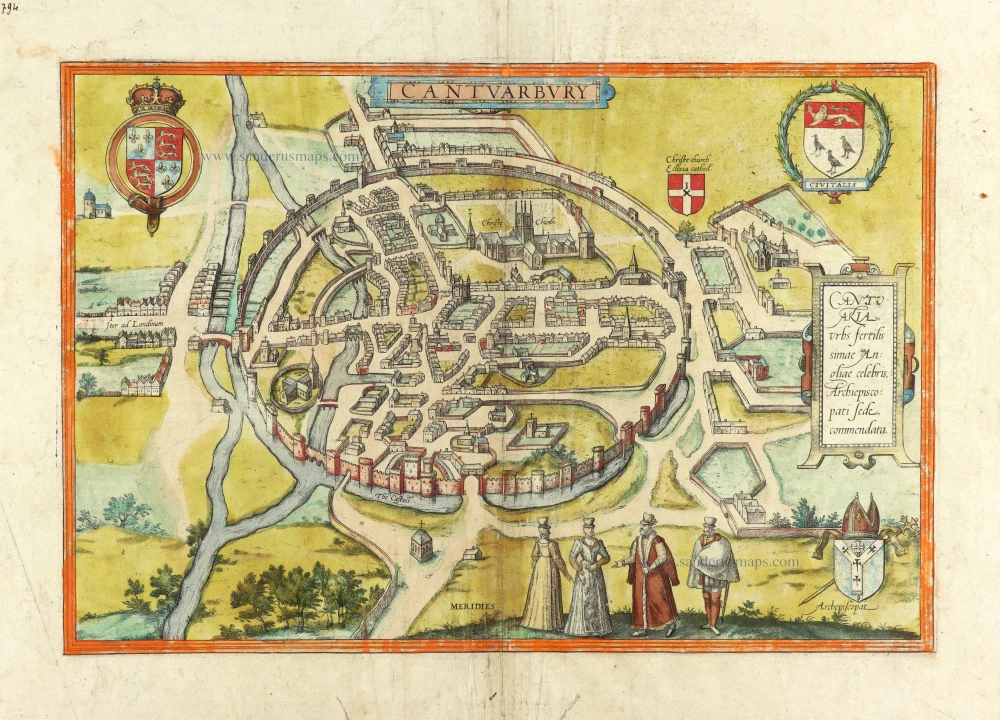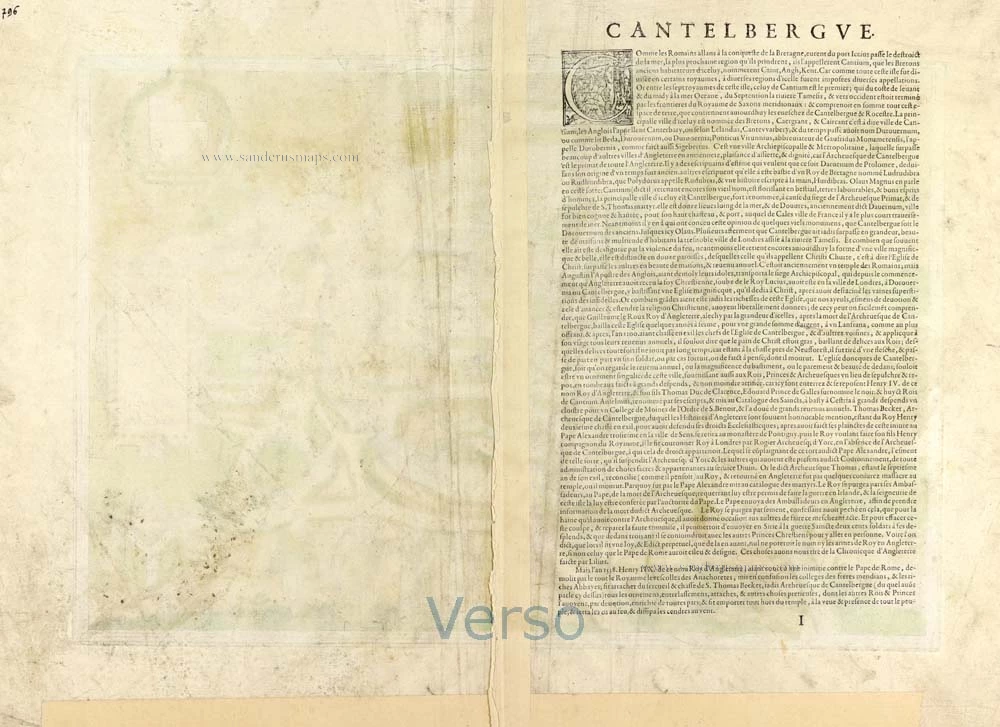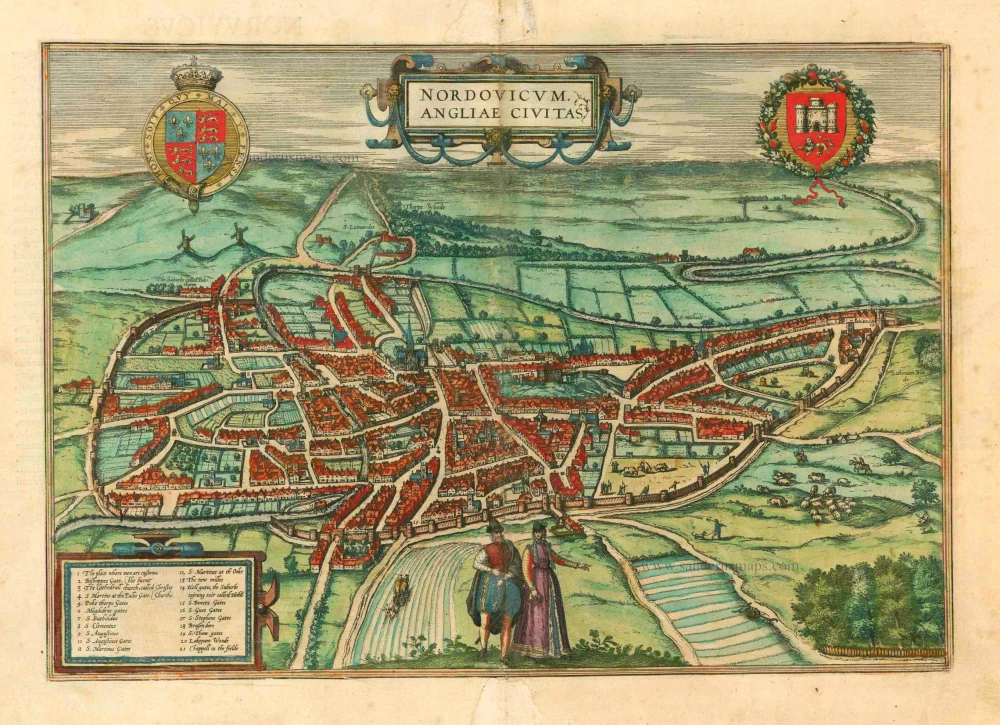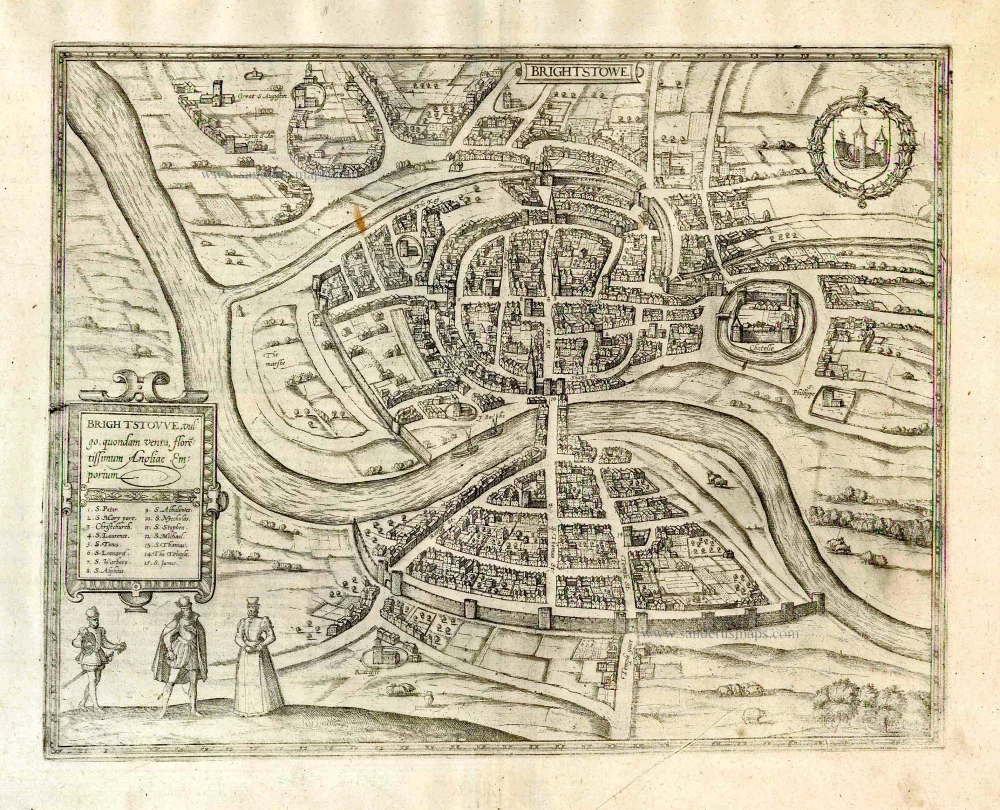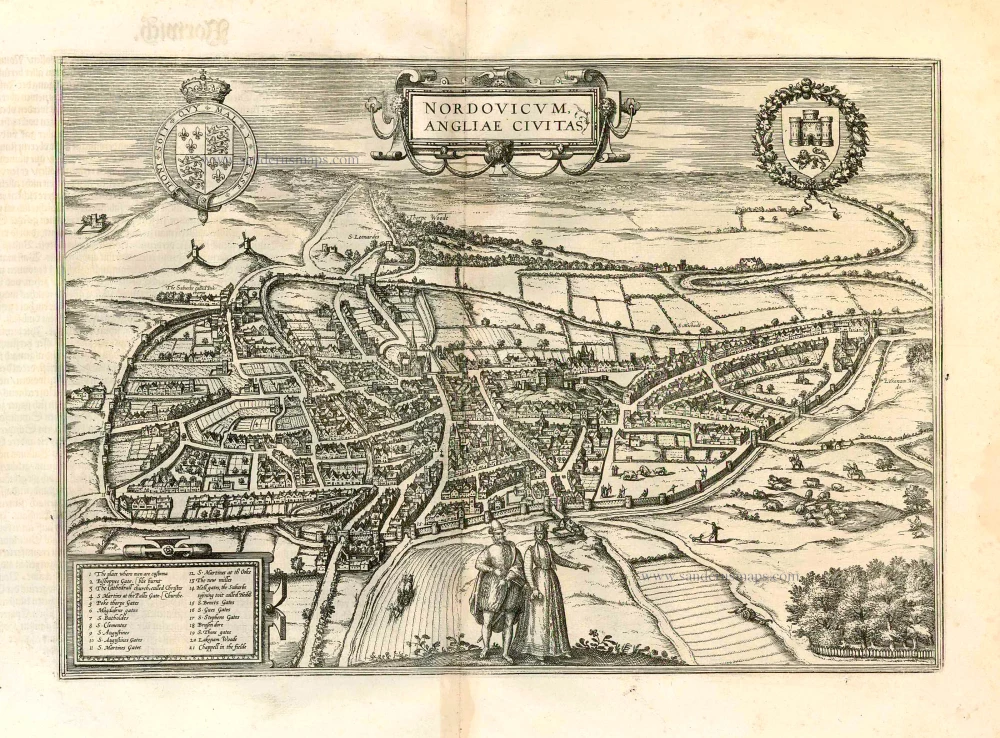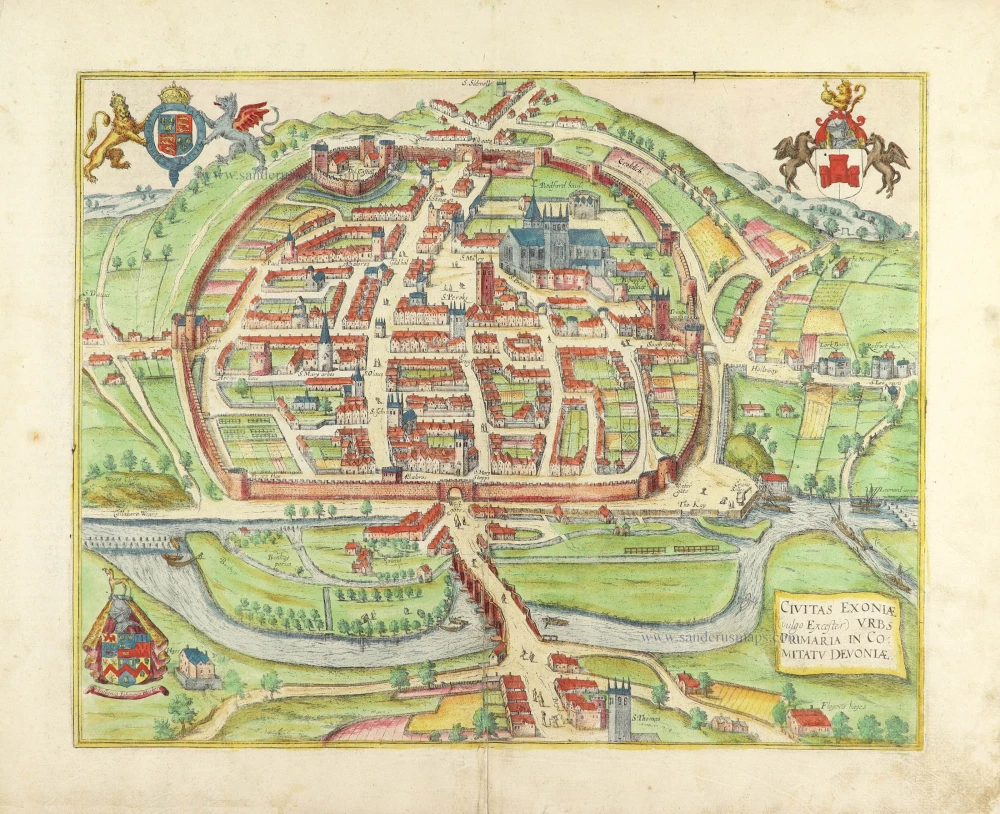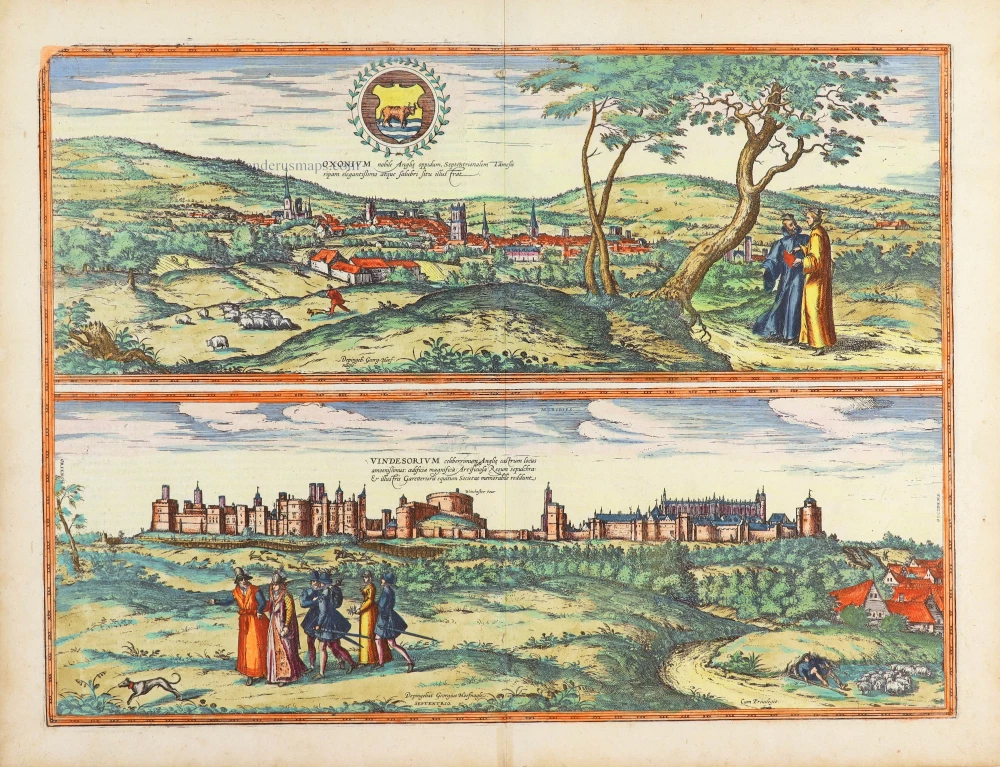Canterbury, by Georg Braun and Frans Hogenberg. c. 1593
TRANSLATION OF CARTOUCHE TEXT: Canterbury is a famous city in the very fertile county of England; it is notable as an archepiscopal see.
COMMENTARY BY BRAUN: "This is the seat of an archbishopric and an administrative capital and is superior to many English cities in age, life and even worthiness. The Archbishop of Canterbury is the most distinguished in the whole of England. [...] The territory of Cantium has kept its old name and has many herds of cattle, cornfields and learned men. Its capital is Canterbury, famous because of its distinguished archbishopric and the tomb of St Thomas the Martyr; it lies twelve miles from the sea near the little town of Dover, formerly called Dubris. [...] But many say that Canterbury once far surpassed the great, splendid city of London, not only in respect of the size and magnificence of its buildings but also the number of its inhabitants."
This bird's-eye view from the south shows Canterbury enclosed within a circular defensive wall. It was originally a Roman city named Durovernum Cantiacorum. In AD 597, Augustine, "Apostle to the English", converted a church dating from Roman times into a cathedral and built a monastery there. From the 11th to the 15th century, the old cathedral was replaced by the building that can be seen today. Archbishop Thomas à Becket was murdered in this church in 1170 because he opposed reintroducing royal privileges within the ecclesiastical sphere. Becket was canonised by Pope Alexander III in 1173. His tomb developed into an essential place of pilgrimage until Henry VIII ordered the destruction of the shrine and the relics in 1538. On the left, the Westgate Tower can be seen next to the bridge over the Stour. The episcopal coat of arms underlines the special status enjoyed by the city in the lower right-hand corner. The Archbishop of Canterbury has been head of the Anglican Church since its separation from Rome in the 16th century. (Taschen)
Braun G. & Hogenberg F. and the Civitates Orbis Terrarum.
The Civitates Orbis Terrarum, also known as the 'Braun & Hogenberg', is a six-volume town atlas and the most excellent book of town views and plans ever published: 363 engravings, sometimes beautifully coloured. It was one of the best-selling works in the last quarter of the 16th century. Georg Braun, a skilled writer, wrote the text accompanying the plans and views on the verso. Many plates were engraved after the original drawings of a professional artist, Joris Hoefnagel (1542-1600). The first volume was published in Latin in 1572 and the sixth in 1617. Frans Hogenberg, a talented engraver, created the tables for volumes I through IV, and Simon van den Neuwel made those for volumes V and VI. Other contributors were cartographers Daniel Freese and Heinrich Rantzau, who provided valuable geographical information. Works by Jacob van Deventer, Sebastian Münster, and Johannes Stumpf were also used as references. Translations appeared in German and French, making the atlas accessible to a wider audience.
Since its original publication of volume 1 in 1572, the Civitates Orbis Terrarum has left an indelible mark on the history of cartography. The first volume was followed by seven more editions in 1575, 1577, 1582, 1588, 1593, 1599, and 1612. Vol.2, initially released in 1575, saw subsequent editions in 1597 and 1612. The subsequent volumes, each a treasure trove of historical insights, graced the world in 1581, 1588, 1593, 1599, and 1606. The German translation of the first volume, a testament to its widespread appeal, debuted in 1574, followed by the French edition in 1575.
Several printers were involved: Theodor Graminaeus, Heinrich von Aich, Gottfried von Kempen, Johannis Sinniger, Bertram Buchholtz, and Peter von Brachel, all of whom worked in Cologne.
Georg Braun (1541-1622)
Georg Braun, the author of the text accompanying the plans and views in the Civitates Orbis Terrarum, was born in Cologne in 1541. After his studies in Cologne, he entered the Jesuit Order as a novice, indicating his commitment to learning and intellectual pursuits. In 1561, he obtained his bachelor's degree; in 1562, he received his Magister Artium, further demonstrating his academic achievements. Although he left the Jesuit Order, he continued his studies in theology, gaining a licentiate in theology. His theological background likely influenced the content and tone of the text in the Civitates Orbis Terrarum, adding a unique perspective to the work.
Frans Hogenberg (1535-1590)
Frans Hogenberg was a Flemish and German painter, engraver, and mapmaker. He was born in Mechelen as the son of Nicolaas Hogenberg.
By the end of the 1560s, Frans Hogenberg was employed upon Abraham Ortelius's Theatrum Orbis Terrarum, published in 1570; he is named an engraver of numerous maps. In 1568, he was banned from Antwerp by the Duke of Alva and travelled to London, where he stayed a few years before emigrating to Cologne. He immediately embarked on his two most important works, the Civitates, published in 1572 and the Geschichtsblätter, which appeared in several series from 1569 until about 1587.
Thanks to large-scale projects like the Geschichtsblätter and the Civitates, Hogenberg's social circumstances improved with each passing year. He died as a wealthy man in Cologne in 1590.
Cantuarbury - Cantuaria Urbs ferrilis simae Angliae celebris Archiepiscopati sede, commendata.
Item Number: 30540 Authenticity Guarantee
Category: Antique maps > Europe > British Isles - Cities
Canterbury, by Georg Braun and Frans Hogenberg.
Title: Cantuarbury - Cantuaria Urbs ferrilis simae Angliae celebris Archiepiscopati sede, commendata.
Date of the first edition: 1588.
Date of this map: c. 1593.
Copper engraving, printed on paper.
Image size: 294 x 432mm (11.57 x 17.01 inches).
Sheet size: 365 x 500mm (14.37 x 19.69 inches).
Verso: French text.
Condition: Original coloured, lower margin reinforced, some creasing and dust soiling in margins. .
Condition Rating: A
From: Liber Quartus - Livre Quatriesme des Principales Villes du Monde, 1593. (Van der Krogt 4, 41:3.4(1593))
TRANSLATION OF CARTOUCHE TEXT: Canterbury is a famous city in the very fertile county of England; it is notable as an archepiscopal see.
COMMENTARY BY BRAUN: "This is the seat of an archbishopric and an administrative capital and is superior to many English cities in age, life and even worthiness. The Archbishop of Canterbury is the most distinguished in the whole of England. [...] The territory of Cantium has kept its old name and has many herds of cattle, cornfields and learned men. Its capital is Canterbury, famous because of its distinguished archbishopric and the tomb of St Thomas the Martyr; it lies twelve miles from the sea near the little town of Dover, formerly called Dubris. [...] But many say that Canterbury once far surpassed the great, splendid city of London, not only in respect of the size and magnificence of its buildings but also the number of its inhabitants."
This bird's-eye view from the south shows Canterbury enclosed within a circular defensive wall. It was originally a Roman city named Durovernum Cantiacorum. In AD 597, Augustine, "Apostle to the English", converted a church dating from Roman times into a cathedral and built a monastery there. From the 11th to the 15th century, the old cathedral was replaced by the building that can be seen today. Archbishop Thomas à Becket was murdered in this church in 1170 because he opposed reintroducing royal privileges within the ecclesiastical sphere. Becket was canonised by Pope Alexander III in 1173. His tomb developed into an essential place of pilgrimage until Henry VIII ordered the destruction of the shrine and the relics in 1538. On the left, the Westgate Tower can be seen next to the bridge over the Stour. The episcopal coat of arms underlines the special status enjoyed by the city in the lower right-hand corner. The Archbishop of Canterbury has been head of the Anglican Church since its separation from Rome in the 16th century. (Taschen)
Braun G. & Hogenberg F. and the Civitates Orbis Terrarum.
The Civitates Orbis Terrarum, also known as the 'Braun & Hogenberg', is a six-volume town atlas and the most excellent book of town views and plans ever published: 363 engravings, sometimes beautifully coloured. It was one of the best-selling works in the last quarter of the 16th century. Georg Braun, a skilled writer, wrote the text accompanying the plans and views on the verso. Many plates were engraved after the original drawings of a professional artist, Joris Hoefnagel (1542-1600). The first volume was published in Latin in 1572 and the sixth in 1617. Frans Hogenberg, a talented engraver, created the tables for volumes I through IV, and Simon van den Neuwel made those for volumes V and VI. Other contributors were cartographers Daniel Freese and Heinrich Rantzau, who provided valuable geographical information. Works by Jacob van Deventer, Sebastian Münster, and Johannes Stumpf were also used as references. Translations appeared in German and French, making the atlas accessible to a wider audience.
Since its original publication of volume 1 in 1572, the Civitates Orbis Terrarum has left an indelible mark on the history of cartography. The first volume was followed by seven more editions in 1575, 1577, 1582, 1588, 1593, 1599, and 1612. Vol.2, initially released in 1575, saw subsequent editions in 1597 and 1612. The subsequent volumes, each a treasure trove of historical insights, graced the world in 1581, 1588, 1593, 1599, and 1606. The German translation of the first volume, a testament to its widespread appeal, debuted in 1574, followed by the French edition in 1575.
Several printers were involved: Theodor Graminaeus, Heinrich von Aich, Gottfried von Kempen, Johannis Sinniger, Bertram Buchholtz, and Peter von Brachel, all of whom worked in Cologne.
Georg Braun (1541-1622)
Georg Braun, the author of the text accompanying the plans and views in the Civitates Orbis Terrarum, was born in Cologne in 1541. After his studies in Cologne, he entered the Jesuit Order as a novice, indicating his commitment to learning and intellectual pursuits. In 1561, he obtained his bachelor's degree; in 1562, he received his Magister Artium, further demonstrating his academic achievements. Although he left the Jesuit Order, he continued his studies in theology, gaining a licentiate in theology. His theological background likely influenced the content and tone of the text in the Civitates Orbis Terrarum, adding a unique perspective to the work.
Frans Hogenberg (1535-1590)
Frans Hogenberg was a Flemish and German painter, engraver, and mapmaker. He was born in Mechelen as the son of Nicolaas Hogenberg.
By the end of the 1560s, Frans Hogenberg was employed upon Abraham Ortelius's Theatrum Orbis Terrarum, published in 1570; he is named an engraver of numerous maps. In 1568, he was banned from Antwerp by the Duke of Alva and travelled to London, where he stayed a few years before emigrating to Cologne. He immediately embarked on his two most important works, the Civitates, published in 1572 and the Geschichtsblätter, which appeared in several series from 1569 until about 1587.
Thanks to large-scale projects like the Geschichtsblätter and the Civitates, Hogenberg's social circumstances improved with each passing year. He died as a wealthy man in Cologne in 1590.

